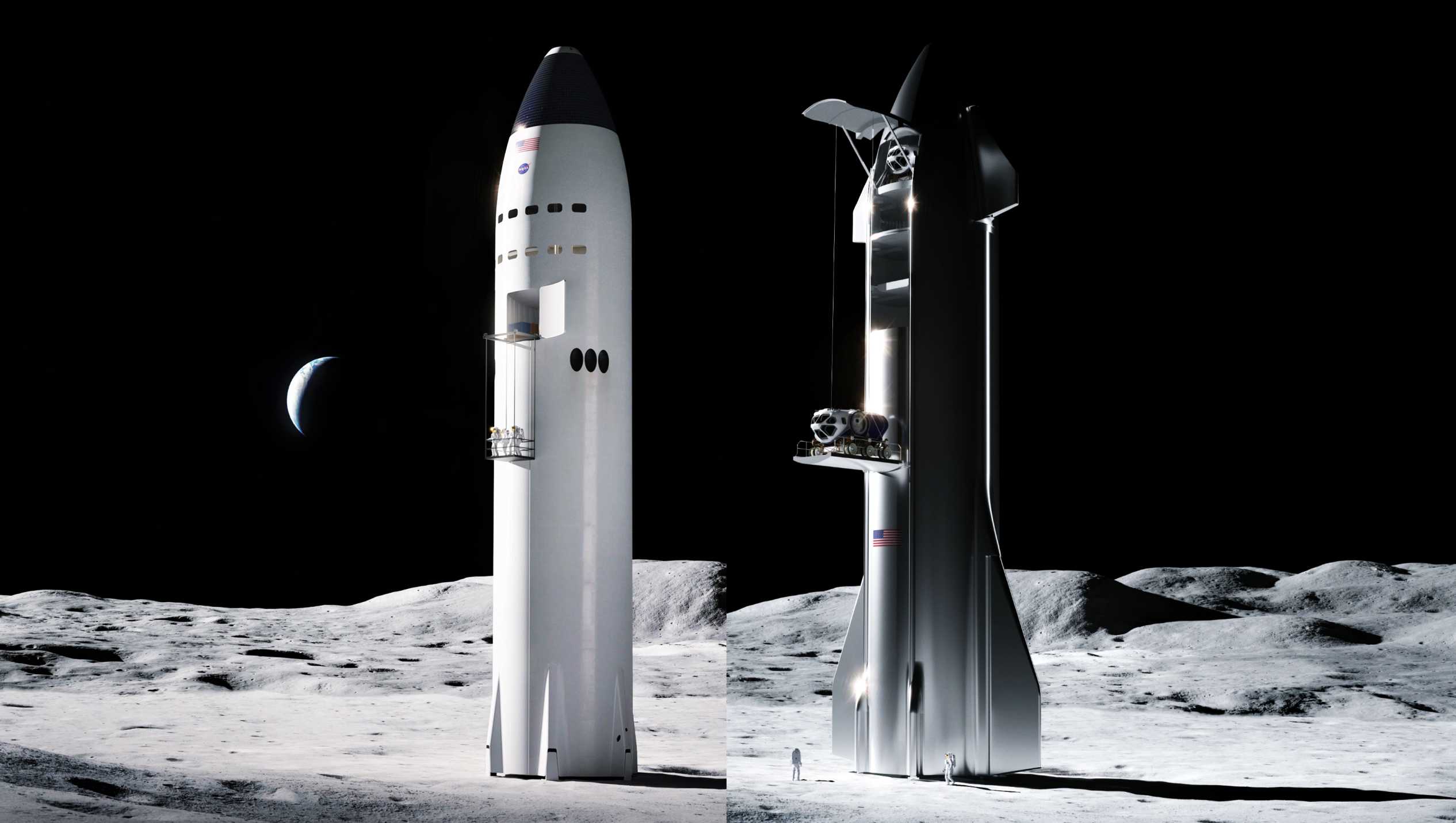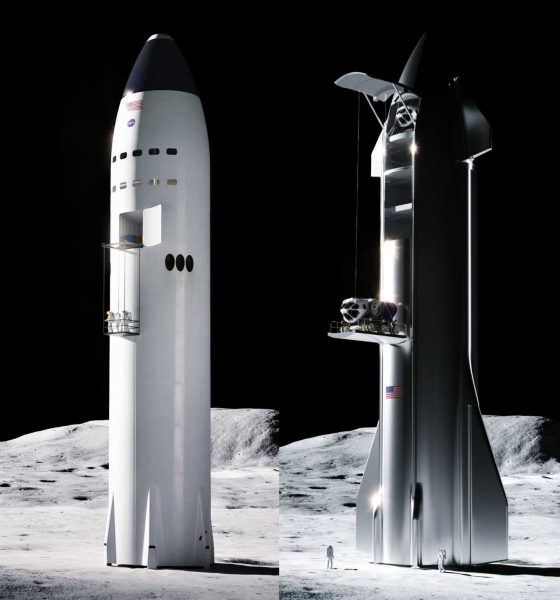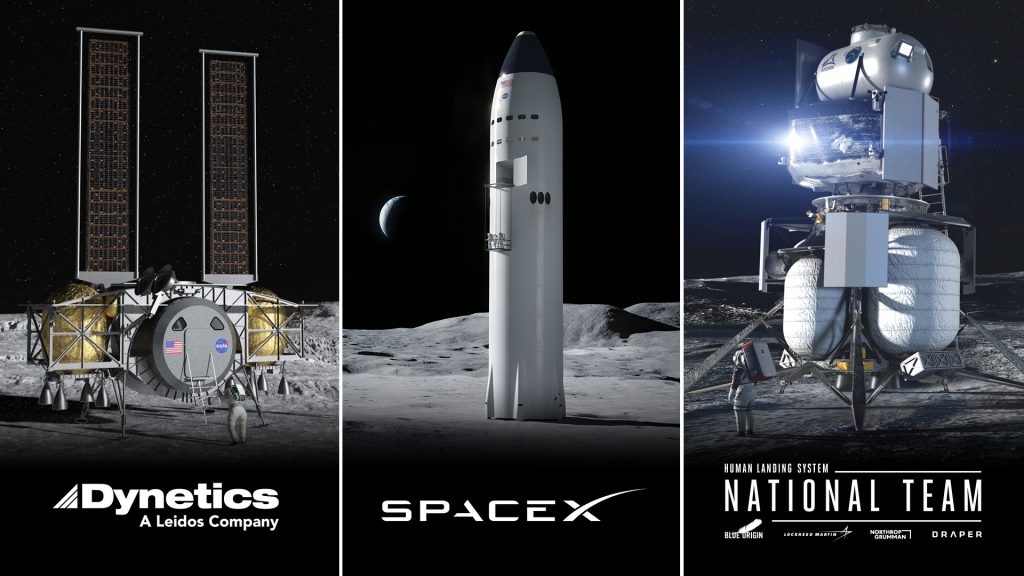

News
SpaceX rapidly builds, tests Starship Moon elevator for NASA
As part of a NASA program that will select one or two commercial crewed Moon landers, SpaceX is busy testing Starship and prototyping hardware and most recently built and demonstrated an elevator “in a very short period of time.”
Known as the Human Landing System (HLS) program, NASA selected three providers – a Blue Origin-led consortium, Dynetics, and SpaceX – to build prototypes and compete for one or two follow-on contracts back in April 2020. SpaceX’s Starship offering was deemed the riskiest solution and the company received a middling $135 million to Dynetics’ ~$250 million and the “National Team’s” ~$570 million.
For their ~$820 million investment, it’s unclear what exactly NASA has gotten from its two best-funded teams aside from paperwork, a few completed design reviews, and two low-fidelity mockups mostly made out of cardboard, foam, and wood. Meanwhile, in the ten months since SpaceX received its $135 million, the company has built no less than eight full-scale Starship prototypes, performed a dozen or more wet dress rehearsals and static fires with said prototypes, and performed two powered hops and two high-altitude test flights. Now, to add to that list of low-cost achievements, SpaceX has also built and tested a functioning prototype of the elevator Starship would use to lift and lower astronauts to and from the lunar surface.
SpaceX’s proposal is certainly a unique one, with Starship being no less than several times taller and heavier than both its prospective competitors. However, Blue Origin’s extraordinarily complex three-stage, four-component lander – requiring a separate transfer stage, descent stage, ascent stage, and crew cabin – makes even Starship seem somewhat reasonable.
Notably, that massive 8-10m (25-32 ft) stack of separate spacecraft – crew cabin at the peak – would force NASA astronauts to transit a several-story ladder to and from the lunar surface. Far taller than the Apollo Program’s lander ladder, which NASA was already somewhat tepid on at the time, navigating a tall ladder in a clumsy, imprecise lunar EVA spacesuit would be extremely challenging and relatively risky. Dynetics is by far the least concerning solution in that regard, requiring what amounts to a footstool relative to SpaceX and Blue Origin.

In the National Team’s defense, SpaceX’s elevator approach is also undeniably risky, and it’s safe to say that demonstrated reliability would be an absolute necessity for NASA to ever accept that solution. Of course, SpaceX could feasibly include a hand-cranked backup system and a ladder on Starship’s exterior in the event of total system failure, but both backups would still pose risks similar to or greater than the National Team’s ladder.
However, the fact that SpaceX has already built and begun testing a Starship Moon elevator prototype makes it hard to believe that the company couldn’t ultimately produce a safe, reliable, redundant elevator between now and the mid to late 2020s.
On a separate note, it’s unclear when or where SpaceX built and tested the first Starship elevator. The photo NASA’s Mark Kirasich provider appears to show an elevator prototype situated inside a steel Starship ring with the sky visible, but nothing like that setup has been spotted at SpaceX’s Boca Chica Starship factory or former Cocoa Beach production facilities. That leaves its Hawthorne, California factory or, perhaps, a mysterious “Roberts Road” facility on Kennedy Space Center (KSC) land. Either way, it certainly appears that SpaceX has yet to show all its cards and is doing everything it can to convince NASA that Starship is worth additional HLS contracts.
NASA is expected to award contracts for full-up Moon lander demonstrations from one or two of the three candidates either “in the next few weeks” or sometime in April.

Elon Musk
Elon Musk and Tesla AI Director share insights after empty driver seat Robotaxi rides
The executives’ unoccupied tests hint at the rapid progress of Tesla’s unsupervised Robotaxi efforts.

Tesla CEO Elon Musk and AI Director Ashok Elluswamy celebrated Christmas Eve by sharing personal experiences with Robotaxi vehicles that had no safety monitor or occupant in the driver’s seat. Musk described the system’s “perfect driving” around Austin, while Elluswamy posted video from the back seat, calling it “an amazing experience.”
The executives’ unoccupied tests hint at the rapid progress of Tesla’s unsupervised Robotaxi efforts.
Elon and Ashok’s firsthand Robotaxi insights
Prior to Musk and the Tesla AI Director’s posts, sightings of unmanned Teslas navigating public roads were widely shared on social media. One such vehicle was spotted in Austin, Texas, which Elon Musk acknowleged by stating that “Testing is underway with no occupants in the car.”
Based on his Christmas Eve post, Musk seemed to have tested an unmanned Tesla himself. “A Tesla with no safety monitor in the car and me sitting in the passenger seat took me all around Austin on Sunday with perfect driving,” Musk wrote in his post.
Elluswamy responded with a 2-minute video showing himself in the rear of an unmanned Tesla. The video featured the vehicle’s empty front seats, as well as its smooth handling through real-world traffic. He captioned his video with the words, “It’s an amazing experience!”
Towards Unsupervised operations
During an xAI Hackathon earlier this month, Elon Musk mentioned that Tesla owed be removing Safety Monitors from its Robotaxis in Austin in just three weeks. “Unsupervised is pretty much solved at this point. So there will be Tesla Robotaxis operating in Austin with no one in them. Not even anyone in the passenger seat in about three weeks,” he said. Musk echoed similar estimates at the 2025 Annual Shareholder Meeting and the Q3 2025 earnings call.
Considering the insights that were posted Musk and Elluswamy, it does appear that Tesla is working hard towards operating its Robotaxis with no safety monitors. This is quite impressive considering that the service was launched just earlier this year.
Elon Musk
Starlink passes 9 million active customers just weeks after hitting 8 million
The milestone highlights the accelerating growth of Starlink, which has now been adding over 20,000 new users per day.

SpaceX’s Starlink satellite internet service has continued its rapid global expansion, surpassing 9 million active customers just weeks after crossing the 8 million mark.
The milestone highlights the accelerating growth of Starlink, which has now been adding over 20,000 new users per day.
9 million customers
In a post on X, SpaceX stated that Starlink now serves over 9 million active users across 155 countries, territories, and markets. The company reached 8 million customers in early November, meaning it added roughly 1 million subscribers in under seven weeks, or about 21,275 new users on average per day.
“Starlink is connecting more than 9M active customers with high-speed internet across 155 countries, territories, and many other markets,” Starlink wrote in a post on its official X account. SpaceX President Gwynne Shotwell also celebrated the milestone on X. “A huge thank you to all of our customers and congrats to the Starlink team for such an incredible product,” she wrote.
That growth rate reflects both rising demand for broadband in underserved regions and Starlink’s expanding satellite constellation, which now includes more than 9,000 low-Earth-orbit satellites designed to deliver high-speed, low-latency internet worldwide.
Starlink’s momentum
Starlink’s momentum has been building up. SpaceX reported 4.6 million Starlink customers in December 2024, followed by 7 million by August 2025, and 8 million customers in November. Independent data also suggests Starlink usage is rising sharply, with Cloudflare reporting that global web traffic from Starlink users more than doubled in 2025, as noted in an Insider report.
Starlink’s momentum is increasingly tied to SpaceX’s broader financial outlook. Elon Musk has said the satellite network is “by far” the company’s largest revenue driver, and reports suggest SpaceX may be positioning itself for an initial public offering as soon as next year, with valuations estimated as high as $1.5 trillion. Musk has also suggested in the past that Starlink could have its own IPO in the future.
News
NVIDIA Director of Robotics: Tesla FSD v14 is the first AI to pass the “Physical Turing Test”
After testing FSD v14, Fan stated that his experience with FSD felt magical at first, but it soon started to feel like a routine.

NVIDIA Director of Robotics Jim Fan has praised Tesla’s Full Self-Driving (Supervised) v14 as the first AI to pass what he described as a “Physical Turing Test.”
After testing FSD v14, Fan stated that his experience with FSD felt magical at first, but it soon started to feel like a routine. And just like smartphones today, removing it now would “actively hurt.”
Jim Fan’s hands-on FSD v14 impressions
Fan, a leading researcher in embodied AI who is currently solving Physical AI at NVIDIA and spearheading the company’s Project GR00T initiative, noted that he actually was late to the Tesla game. He was, however, one of the first to try out FSD v14.
“I was very late to own a Tesla but among the earliest to try out FSD v14. It’s perhaps the first time I experience an AI that passes the Physical Turing Test: after a long day at work, you press a button, lay back, and couldn’t tell if a neural net or a human drove you home,” Fan wrote in a post on X.
Fan added: “Despite knowing exactly how robot learning works, I still find it magical watching the steering wheel turn by itself. First it feels surreal, next it becomes routine. Then, like the smartphone, taking it away actively hurts. This is how humanity gets rewired and glued to god-like technologies.”
The Physical Turing Test
The original Turing Test was conceived by Alan Turing in 1950, and it was aimed at determining if a machine could exhibit behavior that is equivalent to or indistinguishable from a human. By focusing on text-based conversations, the original Turing Test set a high bar for natural language processing and machine learning.
This test has been passed by today’s large language models. However, the capability to converse in a humanlike manner is a completely different challenge from performing real-world problem-solving or physical interactions. Thus, Fan introduced the Physical Turing Test, which challenges AI systems to demonstrate intelligence through physical actions.
Based on Fan’s comments, Tesla has demonstrated these intelligent physical actions with FSD v14. Elon Musk agreed with the NVIDIA executive, stating in a post on X that with FSD v14, “you can sense the sentience maturing.” Musk also praised Tesla AI, calling it the best “real-world AI” today.








